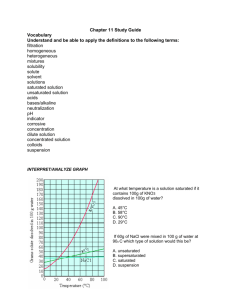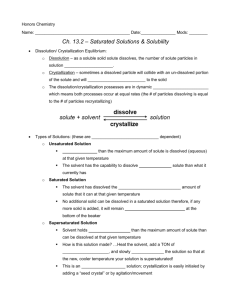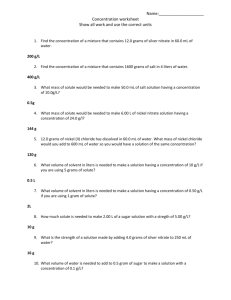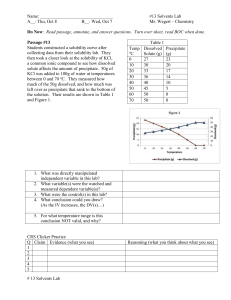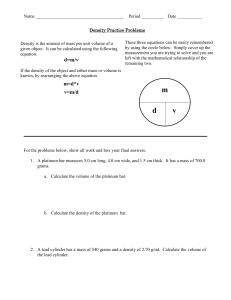Solubility Curves and Solutions Review Sheet
advertisement
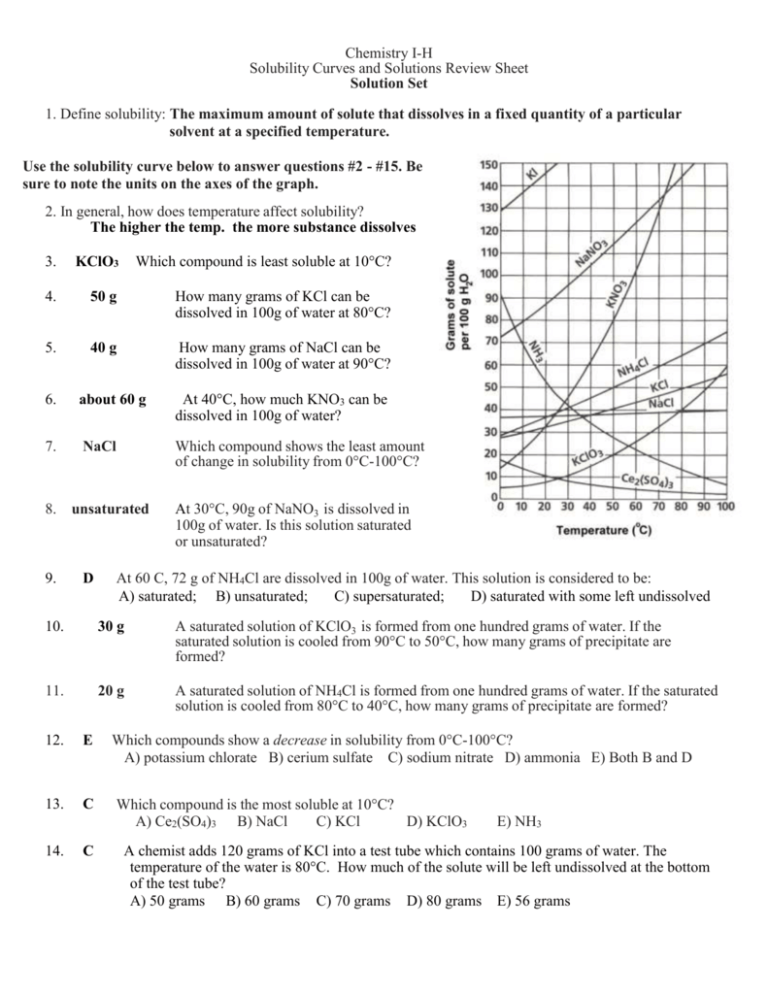
Chemistry I-H Solubility Curves and Solutions Review Sheet Solution Set 1. Define solubility: The maximum amount of solute that dissolves in a fixed quantity of a particular solvent at a specified temperature. Use the solubility curve below to answer questions #2 - #15. Be sure to note the units on the axes of the graph. 2. In general, how does temperature affect solubility? The higher the temp. the more substance dissolves 3. KClO3 Which compound is least soluble at 10°C? 4. 50 g How many grams of KCl can be dissolved in 100g of water at 80°C? 5. 40 g How many grams of NaCl can be dissolved in 100g of water at 90°C? 6. about 60 g At 40°C, how much KNO3 can be dissolved in 100g of water? 7. NaCl Which compound shows the least amount of change in solubility from 0°C-100°C? 8. 9. unsaturated D At 30°C, 90g of NaNO3 is dissolved in 100g of water. Is this solution saturated or unsaturated? At 60 C, 72 g of NH4Cl are dissolved in 100g of water. This solution is considered to be: A) saturated; B) unsaturated; C) supersaturated; D) saturated with some left undissolved 10. 30 g A saturated solution of KClO3 is formed from one hundred grams of water. If the saturated solution is cooled from 90°C to 50°C, how many grams of precipitate are formed? 11. 20 g A saturated solution of NH4Cl is formed from one hundred grams of water. If the saturated solution is cooled from 80°C to 40°C, how many grams of precipitate are formed? 12. E Which compounds show a decrease in solubility from 0°C-100°C? A) potassium chlorate B) cerium sulfate C) sodium nitrate D) ammonia E) Both B and D 13. C Which compound is the most soluble at 10°C? A) Ce2(SO4)3 B) NaCl C) KCl D) KClO3 14. C E) NH3 A chemist adds 120 grams of KCl into a test tube which contains 100 grams of water. The temperature of the water is 80°C. How much of the solute will be left undissolved at the bottom of the test tube? A) 50 grams B) 60 grams C) 70 grams D) 80 grams E) 56 grams -216. What are the 3 different types of mixtures? Define each one. Suspensions, Colloids, and Solutions. A suspension is a heterogeneous mixture containing particles that are distinct from the surrounding medium. A colloid is a suspension in which a solute-like phase is dispersed throughout a solvent-like phase. A solution is a liquid mixture in which the minor component (the solute) is uniformly distributed within the major component (the solvent). 17. How is a solution different from the other two types of mixtures? A solution is different from the other types of mixtures in that it is homogeneous. While a suspension is made up of different phases and a colloid is made up of two distinct, different phases a solution is made up of a solute and a solvent. Finally, a solution cannot be separated once the minor and major products have been mixed. 18. Classify each of the following as a heterogeneous mixture or a homogeneous mixture. a. restaurant ceasar salad heterogeneous b. tap water homogeneous c. muddy water heterogeneous 19. What is the difference between a solute and solvent? The solute (or minor component) is the substance being dissolved while the solvent (or the major component) is the substance doing the dissolving. 20. What is considered to be the “universal solvent? Explain why. Water is called the universal solvent because more substances dissolve in water than in any other chemical due to its polarity. 21. Describe (in detail) the 3 steps in solution formation. Once the solutions have been mixed (1) the solute particles separate from each other which involved overcoming intermolecular attractions (forces). Then (2) the solvent particles separate from each other also involving overcoming intermolecular attractions. Finally, (3) the solute and solvent particles mix where opposite particles attract each other. 22. What is the difference between dissociation and solvation? Dissociation is when ionic compounds separate or split into smaller particles or ions where solvation is the process of surrounding solute particles with solvent particles. In solvation, there is no change in the chemical bonding only in the intermolecular forces. 23. Not all solutions are solids dissolved in liquids. Provide 2 examples of other types of solutions. (A) gas dissolved in liquid: CO2 in H2O (carbonated beverage) (B) solid dissolved in solid: steal solution of carbon atoms in a crystalline matrix of iron atoms 24. List the 3 factors that affect the rate of dissolving 1. “Like dissolves Like” 2. Temperature 3. Pressure -325. Define the terms miscible and immiscible. Miscible: Soluble in any proportion forming a homogeneous mixture Immiscible: incapable of being mixed to form a homogeneous mixture 26. Explain the rule, “Like Dissolves Like”. Like Dissolves Like means that a substance with a certain polarity can only dissolve another substance if it exhibits that same polarity. For example, water and ammonia are polar so they may dissolve each other. Additionally, benzene (C6H6), which is nonpolar, can dissolve other nonpolar substances. 27. In what type of mixture (refer to question 16) is it easiest to separate the component substance? Why? Out of the three types of mixtures, it is easiest to separate the component substance in suspensions because the suspended particles are heterogeneous particles that are visible. 28. State whether each of the following will conduct an electric current. Also, explain why each does or does not conduct an electric current. In order for substances to conduct an electric current they must produce ions in solution. a) salt (NaCl) water YES, produces ions b) sugar water c) solid NaCl NO, no ions in solution NO, no ions present, no solution 29. What is solution equilibrium? Solution equilibrium exists when a chemical compound in the solid state is in chemical equilibrium with a solution of that compound. The equilibrium is an example of dynamic equilibrium in that some individual molecules migrate between the solid and solution phases such that the rates of dissolution and precipitation are equal to one another. When equilibrium is established, the solution is said to be saturated. 30. What are the differences between a saturated solution, unsaturated solution and a supersaturated solution? A saturated solution is one that the maximum amount of solute is dissolved in the solvent at a given temperature. An unsaturated solution has any less than the maximum amount. A supersaturated solution is a special case where more than the maximum amount is dissolved making the solution unstable. Ultimately, the difference is the amount of solute in solvent at a given temperature. 31. How could you tell by looking at a solution that it was saturated? If when additional solute is added and remains undissolved the solution can be viewed as saturated. 32. What is the Tyndall Effect? Cite a common example of this effect. The Tyndall Effect (named after the physicist John Tyndall) occurs when light is scattered by particles in a colloid or particles in a fine suspension. Common examples include blue eyes and flour suspended in water appearing blue. 33. Given an unknown mixture consisting of two substances, explain how a scientist could use lab techniques to determine whether the mixture is a true solution, a colloid, or a suspension. The unknown mixture can be separated by filtration (suspension) or shine light to view scattering (colloid). All others are true solutions. -4Use the solubility curve below to answer the following questions. 34. B Which salt is least soluble at 20°C? A) NaClO3 B) KNO3 C) KBr D) NaCl 35. about 90 g How many grams of KBr can be dissolved in 100g of water at 60°C? 36. 40 g How many grams of NaCl can be dissolved in 100 g of water at 100°C? 37. C Classify the type of solution: At 40°C, 180g of NaClO3 is dissolved in 100g of water. A) saturated B) unsaturated C) supersaturated D) saturated with some left undissolved 38. B Classify the type of solution: At 70°C, 70g of KBr is dissolved in 100g of water. A) saturated B) unsaturated C) supersaturated D) saturated with some left undissolved 39. 30 grams 40. B A saturated solution of NaClO3 is formed from one hundred grams of water. If the saturated solution is cooled from 80°C to 60°C, how many grams of precipitate are formed? A chemist adds 160 grams of KNO3 into a test tube which contains 100 grams of water. The temperature of the water is 50°C. How much of the solute will be left undissolved at the bottom of the test tube? A) 50 grams B) 60 grams C) 70 grams D) 80 grams E) 56 grams

